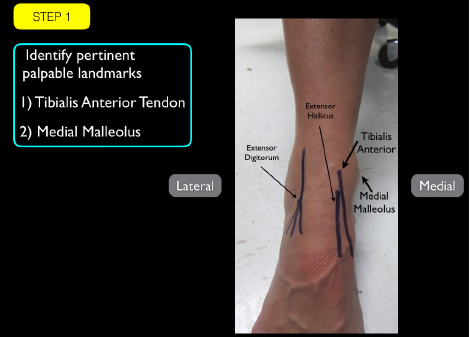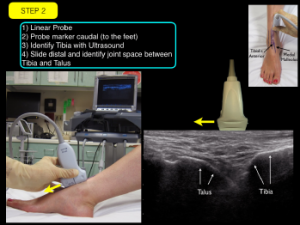Septic arthritis of the ankle is an uncommon but devastating clinical entity representing 3 percent to 14 percent of all septic arthritis cases.1 Diagnostics can prove challenging, especially because systemic symptoms like fever and chills are present in fewer than 50 percent of cases. This forces clinicians to rely on nonspecific and often insensitive physical exam findings, such as pain with joint movement and axial loading.
Explore This Issue
ACEP Now: Vol 39 – No 01 – January 2020In cases of clinical suspicion of a joint infection, point-of-care ultrasound (POCUS) is an ideal bedside tool to determine the presence of joint capsule effusion. Also, POCUS allows a safe and simplified method for joint aspiration.1–3
Ultrasound Examination of the Ankle
Using POCUS for ankle joint assessment starts with good positioning. Place the patient in the supine position with their foot in mild plantar flexion so that the sole rests against the bed. If possible, palpate the anterior tibialis tendon on the anteromedial aspect of the foot. This landmark is easily noted in most patients and acts as an easy starting point when using ultrasound to evaluate the tibiotalar joint.

PHOTOS: Arun Nagdev
The goal is to image just under the anterior tibias tendon or just medial to it. The space between the anterior tibias tendon and medial malleolus is free from tendons or arteries, allowing for an unobstructed evaluation of the ankle joint as well as a safe location for aspiration. We recommend using a high-frequency linear transducer because of the shallow depth of the tibiotalar joint (see Step 1).
We also recommend imaging the nonaffected ankle first to determine a true normal. Place the transducer over the distal tibia (with the probe marker oriented caudally) and visualize the bright hyperechoic line of its bony cortex. Slowly slide the transducer toward the ankle until you are over the space between the tibia and talus (see Step 2). A joint capsule effusion will be an anechoic (dark) fluid collection just above the tibiotalar joint and is clearly seen on ultrasound. A superficial cellulitis and/or abscess can be easily differentiated from a deep joint effusion due to its location close to the probe and connection to the overlying skin (see Step 3).
In patients with an obvious effusion of the joint capsule overlying the tibiotalar joint, the clinician can progress to performing the ultrasound-guided aspiration or call a consultant for assistance. Clinical judgment is needed to determine the need for aspiration because other noninfectious entities can produce joint capsule swelling (eg, gout, arthritis, etc.).
Ultrasound-Guided Ankle Arthrocentesis
Joint aspiration is an aseptic procedure (similar to lumbar puncture and central venous access). We recommend covering the transducer with a sterile probe cover. Use the ultrasound to again locate the joint capsule effusion, making sure the ultrasound screen is in your direct line of sight (ie, the system should not be located behind you—your ergonomics and comfort matter). Once the space is located, we recommend placing either a center line or M-mode line to confirm the middle of the transducer is directly over the joint capsule effusion. A skin wheal of 1–2 cc of anesthetic should be placed just adjacent to the medial aspect of the ultrasound transducer (see Step 4). This will be the location for the aspiration needle entry.


Stabilize the ultrasound transducer with your nondominant hand and have an 18–20-gauge 1.5 in. needle attached to a 5-cc syringe ready for aspiration. Because this is an out-of-plane technique, the operator will not be able visualize the needle entering the joint capsule. However, in our opinion, this is easier overall given the limited space of the tibiotalar joint. Puncture the skin just medial to the midline of the transducer using a very steep angle (just below 90º). The clinician should aspirate as the needle is inserted into the joint capsule because the needle tip may not be clearly visible (see Step 5).
Note: In the photographs for Steps 4 and 5, the sterile cover is not placed over the transducer. These images are to demonstrate transducer and needle positioning.
Summary
POCUS evaluation for joint capsule swelling of the ankle can be an important adjunct in the diagnostic evaluation of a patient with a painful and warm lower extremity. A simplified ultrasound technique for visualizing joint capsule swelling of the medial tibiotalar joint can be rapidly performed at bedside. With this critical information, the clinician can more confidently decide whether to perform an ultrasound-guided joint aspiration (or call a consultant for assistance) to determine the presence of a septic joint.
 Dr. Nagdev is director of emergency ultrasound at Highland General Hospital, Alameda Health System in Oakland, California.
Dr. Nagdev is director of emergency ultrasound at Highland General Hospital, Alameda Health System in Oakland, California.
References
- Movassaghi K, Wakefield C, Bohl DD, et al. Septic arthritis of the native ankle. JBJS Rev. 2019;7(3):e6.
- Roy S, Dewitz A, Paul I. Ultrasound-assisted ankle arthrocentesis. Am J Emerg Med. 1999;17(3):300-301.
- Wisniewski SJ, Smith J, Patterson DG, et al. Ultrasound-guided versus nonguided tibiotalar joint and sinus tarsi injections: A cadaveric study. PM R. 2010;2(4):277-281.
Pages: 1 2 3 | Multi-Page






No Responses to “Using Point-of-Care Ultrasound to Evaluate and Aspirate Ankle Infections”